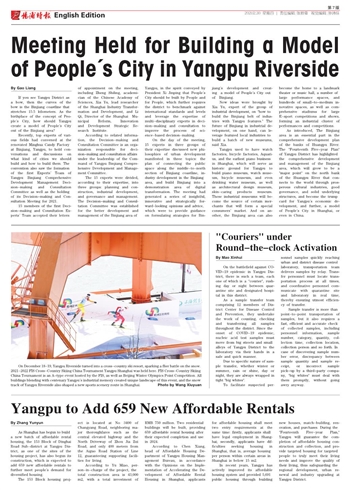By Gao Liang
If you see Yangpu District as a bow, then the curves of the bow is the Binjiang coastline that stretches 15.5 kilometers. As the birthplace of the concept of People's City, how should Yangpu create a model of People's City out of the Binjiang area?
Recently, top experts of various fields had convened at the renovated Minghua Candy Factory at Binjiang, Yangpu, to hold conversations and discussions on what kind of cities we should build and how to build them. The convention also saw the formation of the first Experts' Team of Yangpu Binjiang Comprehensive Development Management Decision-making and Consultation Committee as well as the holding of its Decision-making and Consultation Meeting for 2021.
15 members of the first Decision-making and Consultation Experts' Team accepted their letters of appointment on the meeting, including Zheng Shiling, academician of the Chinese Academy of Sciences, Xia Yu, lead researcher of the Shanghai Industry Transformation and Development, and Li Qi, Director of the Shanghai Municipal Reform, Innovation and Development Strategic Research Institute.
According to related information, the Decision-making and Consultation Committee is an organization responsible for decision-making and consultation affairs under the leadership of the Command of Yangpu Binjiang Comprehensive Development and Management Committee.
The 15 experts were divided, according to their expertise, into three groups: planning and construction, industrial development, and governance and management. The Decision-making and Consultation Committee was established for the better development and management of the Binjiang area of Yangpu, in the spirit conveyed by President Xi Jinping that People's City should be built by People and for People, which further requires the district to benchmark against international standards and levels and leverage the expertise of multi-disciplinary experts in decision-making and consultation to improve the process of science-based decision-making.
On the day of the meeting, 15 experts in three groups of their expertise discussed new philosophies of urban development manifested in three topics: the plan of connecting the public space along the middle-to-north section of Binjiang coastline, industry development in the Binjiang area, and build Binjiang into a demonstration area of digital transformation. The meeting had generated a series of insightful, innovative and strategically forward-looking opinions and advice, which were to provide guidance on formulating strategies for Binjiang's development and creating a model of People's City out of Binjiang.
New ideas were brought by Xia Yu, expert of the group of industrial development, on "how to build the Binjiang belt of industries with Yangpu features." The future of Binjiang in industrial development, on one hand, can leverage featured local industries to build a batch of new museums, said Xia.
Yangpu used to have watch factories, bicycle factories, Aquarius, and the earliest piano business in Shanghai, which will serve as historic ground for Yangpu to build piano museum, watch museum, bicycle museum, and even drinking water museum, as well as architectural design museum, skin-caring products museum. These industrial museums will become the source of certain merchants that will form a special consumers' market. And on another, the Binjiang area can also become the home to a landmark theater or music hall, a number of large performance spaces, and hundreds of small-to-medium innovative spaces, as well as comprehensive stadiums for large E-sport competitions and shows, forming an industrial cluster of performances and competitions.
As introduced, The Binjiang area is an essential part in the comprehensive development plan of the banks of Huangpu River. The "Fourteenth Five-year Plan" of Yangpu District has highlighted the comprehensive development and management of the Binjiang area, which will grow to be a "major point" on the north bank of the Huangpu River that connects to the world through prosperous cultural industries, good governance, and solid underlying structures, and become the trump card for Yangpu's economic development, and further, a model of People's City in Shanghai, or even in China.

